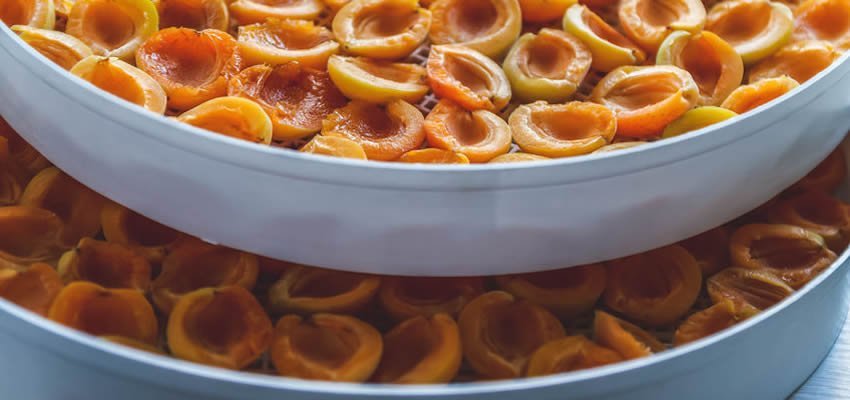Which of the many dehydrators you choose depends on how much dehydrating you plan to do. If you are testing the waters, avoid commitment and start with a DIY setup for your oven. Once you are convinced that dehydrating food is right for you or are already convinced, read on!
In the past, a specific line of dehydrators was the go-to for a lot of preppers, but I haven’t had much luck with them recently. These days, no brand is really any better than another, but there are a few models that stand out. I’ve been very impressed with the NutriChef 6-tray model, which isn’t huge but does a great job and will work for most preppers.
These are the Top 3 Dehydrator Picks for Prepping:
Best Budget Dehydrator

Why I like it: This is a great way to dip your toes into dehydrating without spending too much money. It has very sturdy trays and a top-down circulating system, which isn’t the best but gets the job done. It’s expandable to 12 trays. I’ve been known to throw the trays into the dishwasher with no problem.
The NESCO Snackmaster Pro is available at Amazon.
Most Liked Dehydrator
Why I like it: This food dehydrator has a mid-range capacity with six stainless steel trays. It has a rear-mounted fan and an interior fan to improve circulation, much like how the convection function works on many home oven models. All trays are dishwasher-safe, and it looks nice. I’m not the only one who likes it, as all the reviews I can find are positive.
The NutriChef 6-Tray Countertop Dehydrator is available at Amazon.
Best Dehydrator for Prepping
Why I like it: This is the last stop before getting into the much more expensive commercial dehydrators. It has a lot of drying space – about 28 square feet over 12 trays – and loads of features. It’s a good pick for those who have experience with dehydrating and plan to dehydrate a lot each year.
The Weston Pro 1200 is available at Home Depot.
Why I Picked the NutriChef
It’s not overly expensive, but it has excellent reviews and has enough drying space for the average person.
- I feel good about using stainless steel trays. They’re easy to clean and sanitize and won’t corrode when drying acidic fruits and vegetables.
- It looks good on your countertop, unlike the practical donut-style dehydrators.
- The trays slide in and out pretty quickly, so you don’t need a lot of workspace when rotating.
- It comes with fruit leather trays and screens.
If you have enough counter space to leave it out all the time, do so. Throwing a batch of fruit or veggies into it becomes second nature when it’s in full sight.
About Dehydrators
A food dehydrator is a countertop appliance that circulates warm air through a compartment to dry small pieces of food. There are a handful of different styles, but they all essentially work the same way.
Though you can use an oven to produce similar results, the benefit of a dedicated dehydrator is that it won’t be in your way when you want to make dinner.
More: Learn Why You Should Vacuum Seal Dehydrated Food
Is It Worth Getting a Dehydrator?
In the world of prepping, a good dehydrator is a must. It’s an inexpensive way to convert your fresh garden harvest into shelf-stable foods and ingredients.
Dehydrators reduce food waste by drying food you might have in excess and preparing it for long-term storage. They make great, super-healthy snacks for kids and pets and even make some types of jerky.
Dehydrators also use a lot less energy than an oven would.
What Should I Look For in a Food Dehydrator?
Wattage
- This is the power used to run the dehydrator at its highest setting, which doesn’t necessarily reflect the output. Obviously, a larger unit will require a larger wattage, but if you see small units with big numbers, compare them to similar models before buying.
Temperature ranges
- Look for a range of at least 95°F – 160°F
- There are a few budget models that have no temperature control. Avoid these.
Even airflow
- Side-blowing dehydrators are better than top or bottom-blowing ones.
- Top-blowing dehydrators are better than bottom-blowing ones.
- Look for racks that resemble grids or grill grates rather than sheets with cut-out notches.
- Side fans tend to create better airflow, but most dehydrators still require rack rotation.
Materials
- Avoid clear trays made of acrylic – if you sanitize with heat, acrylic won’t hold up over time.
- Heavy-duty plastics or stainless-steel trays are best. Watch for cheap coated steel trays, as they are tough to care for.
Timer
- This is a feature that is your preference. I don’t bother, personally, because I’m always checking my product.
- Auto-shutoff timers can limit the total time a dehydrator can run. Make sure your product has enough dry time if the timer is on.
How Do I Choose a Dehydrator?
Avoid stacking tray dehydrators where the fan is on the bottom. There is potential for juices to drip down into the machine, which is difficult and dangerous to clean.
Though the donut-style, round dehydrators aren’t quite as good as the cabinet-style ones, they are more affordable and still do a decent job. Look for a style that has extra trays/tray types available.
A digital display is a neat feature but really doesn’t make a difference overall.
Conclusion
I hope I answered all of your questions about buying dehydrators, but this list is not exhaustive. There are several good dehydrators on the market, but these are the ones that I have experience with.
If you have any questions that I can help you with, please contact me, and I will do my best to help you. Your questions help me to help everyone else!




